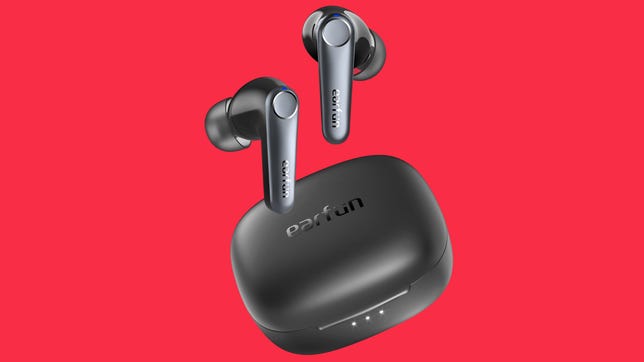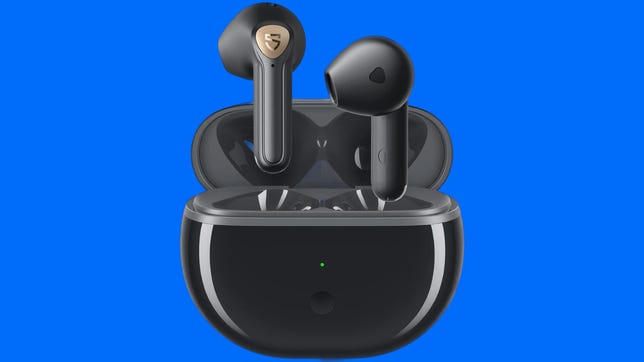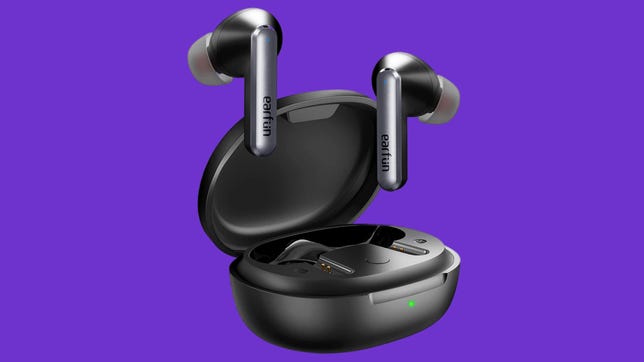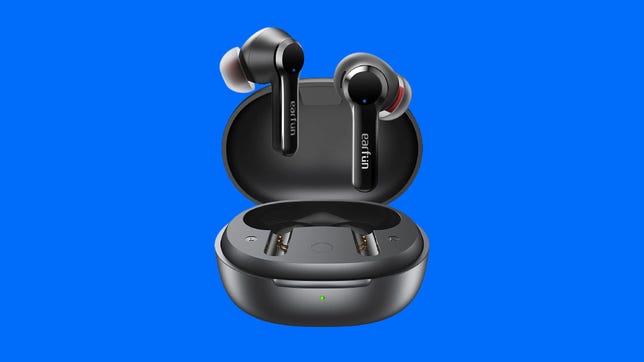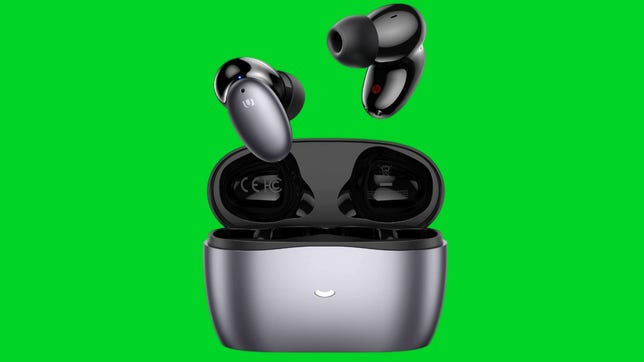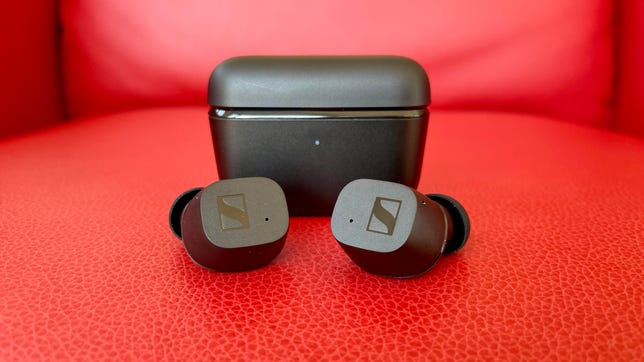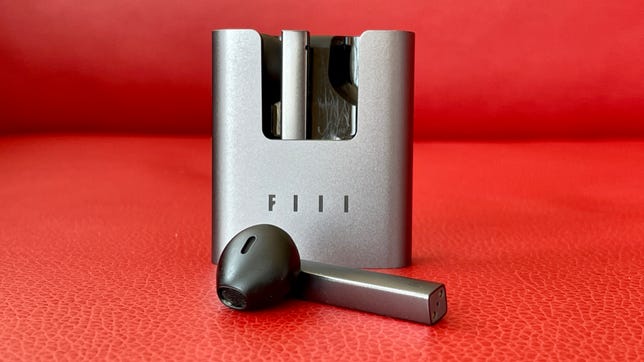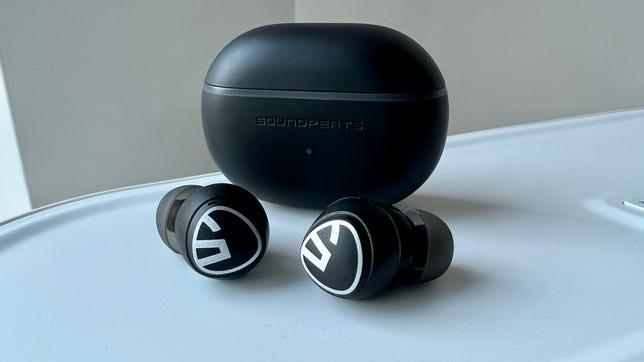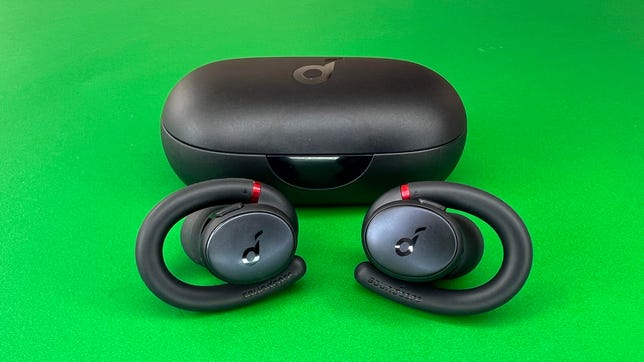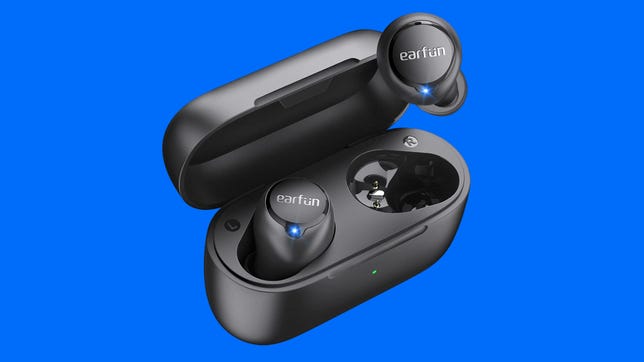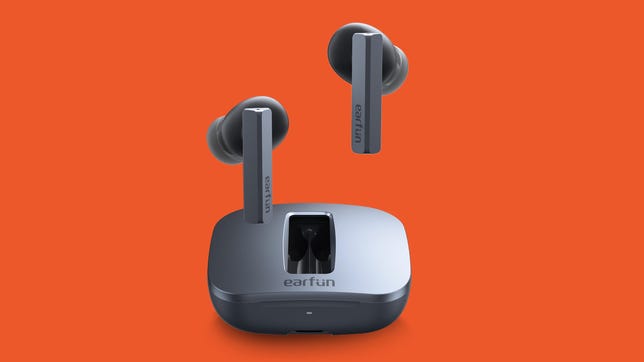Technologies
Best Cheap Wireless Earbuds for 2023: Great Budget Picks
Looking for AirPods alternatives that cost less? Here are some of the best budget wireless earbuds worth considering.

Premium wireless earbuds like Apple’s AirPods Pro 2, Sony’s WF-1000XM4 or Bose’s QuietComfort Earbuds 2 may be excellent, but a lot of people just can’t afford them (or just don’t think they’re worth what they cost). But the good news is that you don’t need to spend a lot to be able to afford good sounding earbuds. There are a number of affordable and even downright cheap wireless earbuds that not only offer decent audio quality but perform well overall, with solid battery life, reliable Bluetooth connectivity and good voice call quality for both Apple and Android devices.
I’ve tested a variety of budget true-wireless earphones and found some standout AirPods alternatives for budget-conscious shoppers. All of my picks for the best cheap wireless earbuds cost $100 or less — and several of these Bluetooth true-wireless earbuds cost less than $50.
For these mini reviews, I’ve included info on battery life, audio quality and key features, including whether they have active noise canceling or not, plus their IPX water-resistant rating in case you’re interested in using these for running or working out at the gym. I’ll update this list as other top affordable wireless earbuds are released.
Read more: Best Wireless Earbuds for 2023
Earfun has put out a series of wireless earbuds over the last couple of years with one important thing in common: They’re very good values, made more so by frequent discounts. The company’s new-for-2023 Earfun Air Pro 3 earbuds feature the latest Qualcomm QCC3071 system-on-a-chip with aptX Adaptive for Android and other devices that support the new LE Audio standard and LC3 audio codec, which is superior to the SBC codec (they also support AAC for Apple devices).
Lightweight and comfortable to wear — I got a good seal with the largest ear tip size — these aren’t a huge upgrade over the Earfun Air S, but they are better. They have slightly larger wool-composite drivers (11mm versus 10mm), slightly improved noise canceling and better battery life (up to seven hours with noise canceling on, according to Earfun).
In short, the Earfun Air 3 deliver strong performance for their modest price, with robust bass, good clarity and a relatively wide soundstage. They also pack in a lot of features, including a wireless charging case and «multidevice» connectivity. (I could pair them to two devices simultaneously but had to pause the music on one device and hit play on the other for the audio to switch.) They’re IPX5 splash-proof and also work well, though not exceptionally well, as a headset for making calls.
Note that after you activate the instant 10%-off coupon at Amazon, adding the code EAP3CNET at checkout gives you an additional 20% off, bringing the buds’ price down to $56.
Here’s a deal worth checking out on a set of open earbuds that perform surprisingly well: the Soundpeats Air3 Deluxe HS. Their list price is $50, but there is currently an extra 20% off on-page coupon that drops the price to $40 for a limited time.
What makes these Soundpeats Air3 Deluxe HS buds special is that they sound surprisingly good for open earbuds — they’re pretty close to what you get from Apple’s AirPods 3 for sound. On top of that, they support Sony’s LDAC audio codec for devices that offer it. Not too many cheap open earbuds have good sound but these Soundpeats have good bass response and clarity. They’re also good for making calls and have a low-latency gaming mode.
In the past, we’ve recommended Earfun’s AirPro SV and Air Pro 2 as excellent budget noise-canceling earbuds choices (they’re still good values). But the new-for-2022 Earfun Air S may be the best of the trio, with multipoint Bluetooth pairing and the latest Qualcomm QCC3046 chip with the aptX audio codec for Android and other devices that support it. They have the same 10mm wool drivers as the AirPro SV and feature surprisingly impressive sound for their modest price. They also work well as a headset for making calls with decent background noise reduction. The buds have an IPX5 water-resistance rating, which means they’re splashproof and can withstand a sustained spray of water.
Note that the earbuds cost as low as $49 when you apply the CNET-exclusive discount code EFAIRS07 at checkout at Amazon, or the code E4AH201 at Earfun’s online store.
Battery Life
Rated up to 8 hours
Noise Canceling
No
Multipoint
No
Headphone Type
Wireless earbuds
Water-Resistant
Yes (IPX7 — can be submerged for 30 minutes up to 1 meter)
The Tranya T20 earbuds remind me a little of a cheaper version of Samsung’s Galaxy Buds 2 without the noise canceling. They’re no-frills and don’t have features such as ear-detection sensors that automatically pause your music when you take a bud out of your ears. But they sound surprisingly decent for their modest price. If you get a tight seal, they sit pretty flush with your ears (they don’t really stick out much) and they have decent battery life — up to eight hours at moderate volume levels. They also work pretty well for making calls and are IPX7 waterproof.
The case feels a little cheap and the buds are lightweight. The Galaxy Buds 2 definitely feel more premium. However, the buds are well-tuned and have a relatively wide soundstage. Don’t expect the world from them and I think you’ll be pleasantly surprised.
Battery Life
Rated up to 7 hours
Noise Canceling
Yes (ANC)
Multipoint
No
Headphone Type
Wireless earbuds
Water-Resistant
Yes (IPX5 — protection against low-pressure water streams)
The Earfun Air Pro 2 earbuds have solid active noise cancellation, and their sound is also impressive for their relatively modest price, with overall well-balanced sound, decent clarity and solid bass performance. Some of Earfun’s buds have had a bit too much treble push — referred to as «presence boost» — but these mostly manage to avoid that. They do sound better than the original Air Pro earbuds.
They have some extra features, like an ear-detection sensor so your music pauses when you take the buds out of your ears, and a case that has USB-C and wireless charging, which you don’t often find at this price. Equipped with Bluetooth 5.2, they’re splash-proof with an IPX5 rating and offer up to seven hours of battery life on a single charge at moderate volume levels, though you’ll probably get closer to six hours with noise cancellation on.
There’s also a transparency mode that lets ambient sound in. It sounds pretty natural and is closer than I thought it would be to the AirPods Pro earbuds’ excellent transparency mode. Alas, there’s no companion app that allows you to tweak the sound or upgrade the firmware.
Earfun talks up the Air Pro 2 model’s voice-calling capabilities — the buds have three microphones in each earbud — and I thought call performance was good but these didn’t reduce background noise as much the new Soundpeats T3, which are also good for the money ($40). However, while the Soundpeats T3 are better for calls, the Earfun Air Pro 2 earbuds’ noise-canceling and transparency modes are superior and the Soundpeats don’t have the ear-detection sensor. Also, the Earfun Air Pro 2 buds sound better, with richer, more dynamic sound.
The Jabra Elite 3 headphones are Jabra’s most affordable true-wireless earbuds to date and have a fairly basic feature set, though they offer strong sound and call quality for the money. They have 6mm drivers, four microphones for calls and Jabra’s HearThrough transparency mode. Qualcomm aptX HD audio is supported for aptX-enabled devices.
Battery life is rated at up to seven hours on a single charge at moderate volume levels, with the case storing an extra three full charges (28 hours total). They have an IP55 water-resistance rating, which means they can take a sustained spray of water and are also dust-resistant. As with a lot of other new buds, you can use either bud independently in a mono mode.
While they don’t have such extras as active noise canceling, the Elite 3 earbuds offer solid performance and a comfortable fit for a reasonable price.
Battery Life
Rated up to 10 hours
Noise Canceling
No
Multipoint
No
Headphone Type
Wireless earbuds
Water-Resistant
Yes (IPX4 — splash-proof)
Sony’s entry-level C500 earbuds don’t feature active noise canceling and are pretty basic as far as earbuds go, with no ear-detection sensors or transparency mode. But the buds are compact and lightweight, fit comfortably and sound good for an entry-level model.
While these earbuds have background noise reduction during voice calls, they only have one microphone in each earbud. Many earbuds now have two or more microphones to help process ambient noise and capture your voice.
In some ways, these are similar to Jabra’s new $80 Elite 3 earbuds, delivering respectable sound quality for less than $100 (but you’ll want to buy them for less than $60). The C500 don’t have the richer, more refined — and dynamic — sound of the high-end WF-1000XM4, but they have ample bass and decent clarity, as Sony says they benefit from its Digital Sound Enhancement Engine technology that it says helps «restore high-frequency sound to create a more authentic listening experience.»
The earbuds are rated IPX4, so they’re splash-proof, and offer up to 10 hours of battery life at moderate volume levels on a single charge. That’s very good.
Battery Life
Rated up to 6 hours
Noise Canceling
Yes (ANC)
Multipoint
No
Headphone Type
Wireless earbuds
Water-Resistant
Yes (IPX5 — protection against low-pressure water streams)
Yes, Ugreen’s HiTune X6 buds are a bit weird looking, but they should fit most ears well and come with a few different sizes of ear tips (I went with large). Their charging case feels solid, and the buds themselves don’t look or feel cheap. IPX5 splash-resistant, they feature active noise canceling — it does manage to muffle a reasonable amount of ambient noise — but their best feature is arguably their sound. They offer good clarity along with a wide soundstage and very plump bass that avoids being boomy. They sound as good as many buds that cost more than $100 and sometimes even $150. Note that to get the $26 price on Amazon, there’s a coupon box that must be checked on the product page.
There are some caveats. First, I noticed that these sound better with the noise canceling off (they lose some clarity with it on). Also, while the included tips should fit most people’s ears, I swapped in a pair of my favorite tips and got an even tighter seal, which improved sound quality.
Battery Life
Rated up to 9 hours
Noise Canceling
No
Multipoint
No
Headphone Type
Wireless earbuds
Water-Resistant
Yes (IPX4 — splash-proof)
The Sennheiser CX earbuds sound excellent for their price point but do stick out of your ears a little more than some buds. (Note that there’s also the new Sennheiser CX Plus model, which adds noise canceling for $50 more and sounds very similar.)
The buds are equipped with Bluetooth 5.2 and battery life is up to nine hours at moderate volume levels (the slightly bulky charging case stores an additional three charges) versus seven hours for the previous model. The CX also adds an extra microphone on each bud, which does improve the voice-calling experience from the earlier CX400 and makes it easier for callers to hear you speak, even in noisy environments. To be clear, however, these are not active noise-canceling earbuds — they simply offer noise reduction for calls. They have an IPX4 rating and are splash-proof. Read our Sennheiser CX first take.
Battery Life
Rated up to 6 hours
Noise Canceling
Yes
Headphone Type
Wireless earbud
Water-Resistant
No IP rating, advertised as sweat-proof
I never tried the original Fiil CC earbuds, but the next-generation CC2 improves on the performance of the originals, with better battery life (they’re rated at five hours on a single charge) and no audio latency issues when watching videos.
These did stay in my ears better than the standard AirPods. They pair quickly — they’re equipped with Bluetooth 5.2 — there’s a Fiil companion app for tweaking settings and they sound quite decent for open-style buds, with just enough bass to keep you from feeling they’re bass shy. They’re also decent for making calls and have touch controls.
One of their distinguishing features is their open case, which makes it easy to access the buds and put them back in their case. Thanks to some integrated magnets, they stay in the case securely — you can turn it upside down and the buds won’t come out. Unlike the AirPods, these have square, not rounded, stems, which seems a little weird at first, and they do fit in your ears slightly differently than AirPods as a result.
Battery Life
Rated up to 6 hours
Noise Canceling
Yes (ANC)
Multipoint
No
Headphone Type
Wireless earbuds
Water-Resistant
Yes (IPX4 — splash-proof)
The Soundpeats Air Pro 3 are lightweight buds that sound quite good and offer decent noise canceling for their modest price. They use Qualcomm’s latest QCC3046 chipset (Bluetooth 5.2) with the aptX Adaptive Bluetooth audio streaming that’s supported by many Android smartphones. They’re IPX4 splash-proof and have a battery life of six hours, with an additional three charges in their compact charging case, which is around the same size as the AirPods Pro’s case.
While the buds’ biggest strengths are their lightweight design and sound quality (you get big, bold sound with strong bass that only lacks that extra bit of clarity and definition that higher-end buds offer), the only downside is the voice-calling performance is only so-so — callers said the microphone pickup and voice clarity just wasn’t as good as some earbuds we’ve tested and reduction of background noise was not great either. In other words, don’t buy these if voice calling is a priority.
Battery Life
Rated up to 6 hours
Noise Canceling
Yes (ANC)
Multipoint
No
Headphone Type
Wireless earbuds
Water-Resistant
Yes (IPX5 — protection against low-pressure water streams)
I was a fan of Earfun’s earlier Free Pro earbuds, which offer good sound for around $50 and have little sport fins that help keep them in your ears securely. Now Earfun has released the Earfun Pro 2 buds with aluminum alloy caps, improved noise canceling and a couple of extra microphones that help boost voice-calling performance.
The Free Pro 2 deliver good sound for their modest price, with decent clarity and deep but well-defined bass. They produce relatively big, open sound. They don’t have such extra features as an ear-detection sensor so your music automatically pauses when you take one or both earbuds out of your ears, or an app that allows you to update their firmware. But they’re lightweight, should fit most ears well and have decent noise canceling along with a transparency mode. (It’s not as good as the AirPods Pro’s transparency mode, which is hard to beat.)
I found the voice-calling performance good but not great. They did an acceptable job reducing background noise and picking up my voice in noisy environments but they aren’t necessarily top-notch in this department. Battery life is rated at up to six hours, they’re IPX5 splash-proof and their elongated case, which charges wirelessly, is compact and lightweight. It’s better designed than the Free Pro’s case.
Battery Life
Rated up to 5.5 hours
Noise Canceling
Yes (ANC)
Multipoint
No
Headphone Type
Wireless earbuds
Water-Resistant
Yes (IPX4 — splash-proof)
The Soundpeats T3 buds have two things going for them aside from their modest price tag: They sound decent and work well for making calls, offering good noise reduction. They’re also comfortable to wear and have both active noise canceling and transparency mode. The noise canceling is only OK, not great (same goes for the transparency mode), but you can’t expect everything for such a low price.
Equipped with Bluetooth 5.2, they’re IPX4 splash-proof and have a battery-life rating of up to five and a half hours on a single charge at moderate volume levels.
They have relatively smooth, balanced sound and ample bass. They’re not going to wow you with clarity or dynamic sound, but they’re pleasant to listen to, which is all you can ask of a budget set of earbuds.
Callers said that my voice sounded clearer when I was using the AirPods Pro but the Soundpeats actually reduced more background noise that the AirPods Pro. I was able to have conversations on the noisy streets of New York without a problem.
Battery Life
Rated up to 7 hours
Noise Canceling
Yes (ANC)
Multipoint
No
Headphone Type
Wireless earbuds
Water-Resistant
Yes (IPX5 — protection against low-pressure water streams)
The Soundpeats Mini Pro have a few things going for them. For starters, they’re relatively compact and fit my ears comfortably and securely (I got a tight seal with the largest included ear tips). They also sound surprisingly good, with clear, nice-detailed sound and punchy bass. They sound as good or better than buds I’ve used in the $100 to $150 price range. Also, since they’re powered by a Qualcomm Bluetooth chip (it’s Bluetooth 5.2), they have support for Qualcomm’s aptX audio codec, which can offer slightly better sound on aptX-enabled devices such as some Android phones.
These are IPX5 splash-proof active noise-canceling earbuds. While the noise cancellation muffles background noise to a degree, it isn’t as effective as what you get with Apple’s AirPods Pro or top noise-canceling buds from Sony and Bose. Battery life is rated at up to seven hours with noise canceling off and five hours with it on.
On a more critical note, voice-calling performance was only average. In quieter environments they work decently, but outdoors in the streets of New York, callers said they heard a lot of background noise and they didn’t do well with wind noise. The Soundpeats T3 ($36) are better for voice calling but these Mini Pro buds sound significantly better.
The new Soundcore Sport X10 have an interesting design with rotating, swiveling ear hooks that flip up when you’re using them and flip down when you want to set them in their charging case, which has a smaller footprint than for a lot of earbuds with ear hooks.
As long as you get a tight seal, they sound good, with powerful, punchy bass and good detail. They also have active noise canceling, which is effective though not as good as Sony’s or Bose’s. They’re also fully waterproof with an IPX7 rating, which means they can be fully submerged in up to 3 feet of water for 30 minutes. Battery life is rated at up to eight hours with an additional three charges in the charging case.
Battery Life
Rated up to 7 hours
Noise Canceling
Yes (Qualcomm cVc 8.0)
Multipoint
Yes
Headphone Type
Wireless earbuds
Water-Resistant
Yes (IPX7 — can be submerged for 30 minutes up to 1 meter)
I was a fan of the original Earfun Free buds, and now there’s an upgraded version called the Earfun Free 2 (which has been subsequently upgraded to the 2S). They’re not a huge upgrade, but like the originals they fit my ears well and deliver decent bang for the buck with strong sound — it has just a touch of treble and bass boost (there’s plenty of bass) — and extra features such as wireless charging.
Battery life is rated at up to seven hours at moderate volume levels, and these buds are fully waterproof with an IPX7 rating. These are equipped with Bluetooth 5.2 and use Qualcomm’s QCC3040 chip that includes support for the aptX audio codec if you’re using a compatible device (certain Android smartphones support that protocol).
The Earfun Air Pro SV have a few things going for them. First, they sound shockingly good for a set of earbuds in this price range. They feature big, open sound with well-defined bass and good clarity. They’re also lightweight and comfortable to wear, their noise canceling is effective and they have a fairly natural-sounding transparency mode that allows ambient sound in if you want to hear the outside world around you for safety reasons.
Earfun is highlighting how you can see the buds’ squared-off stems through the case — there’s a little window — but aside from the stems, the buds themselves have a similar shape and design to the AirPods Pro. While the case offers wireless charging, the buds are missing a sensor that pauses your music when you take them out of your ears (you can use a single bud if you want) and resumes playback when you put them back in. Their touch controls work reasonably well. They’re IPX5 splash-proof, and battery life is rated at six hours with noise canceling turned on. There’s also a low-latency gaming mode and you can upgrade the buds’ firmware and tweak sound settings in a companion app for iOS and Android.
Earfun talks about them having «six professional mics for a stunning call experience» — and they do work decently enough for calls — but I was slightly disappointed with the noise reduction while using them in the streets of New York. Aside from that small gripe, they’re a very good value, particularly now that Earfun is offering them for $54 when you input the code SUMMER40 (40% off) at checkout on its site.
Do cheap earbuds sound as good as the AirPods 3rd Gen and AirPods Pro 2?
Apple improved the sound quality of the third-gen AirPods so it raised the bar. That said, many true wireless earbuds that cost less than $100 or even less than $50 offer surprisingly good sound for the money and measure up pretty well against the AirPods and AirPods Pro, though not the AirPods Pro 2, which offer significantly improved sound.
What are the biggest differences between cheaper buds and more premium buds?
Often, the biggest difference is build quality. Premium buds tend to feel sturdier and tend to be built with more premium materials. They also have a more premium look and feel to both the buds themselves and their charging case. In theory, premium buds should hold up better over time. Additionally, they tend to have more features such as ear-detection sensors and they pair with a companion app so you can upgrade the firmware (as well as tweak the sound and possibly customize the controls). Finally, while some cheaper buds have active noise cancellation, the performance of the noise-canceling and transparency modes tends to be better with more premium buds.
Do cheap earbuds work well for making voice calls?
Some do. Many cheaper buds now feature multiple microphones and some do a surprisingly good job when it comes to voice calling. A few models on this list have surprisingly good noise reduction and measure up well against the AirPods, which are known for their strong voice-calling performance.
Technologies
Before You Order a $20K Home Robot, There’s Something You Should See
It’s designed to do your chores — with some help from folks behind the curtain.

The robot stands 5 feet 6 inches tall, weighs about as much as a golden retriever and is nearly the price of a brand-new budget car.
This is Neo, the humanoid robot. It’s billed as a personal assistant you can talk to and eventually rely on to handle everyday tasks, including loading your dishwasher and folding your laundry.
Neo doesn’t come cheap: it’ll cost you $20,000. And even then, you’ll still have to train this new home bot, and possibly need a remote assist as well.
If that still sounds enticing, preorders are now open (for $200 down). You’ll be signing up as an early adopter for what Neo’s maker, a California-based company called 1X, is calling a «consumer-ready humanoid.» That’s opposed to other humanoids under development from the likes of Tesla and Figure, which are, for the moment at least, more focused on factory environments.
Neo is a whole order of magnitude different from robot vacuums like those from Roomba, Eufy and Ecovacs, and embodies a long-running sci-fi fantasy of robot maids and butlers doing chores and picking up after us. If this is the future, read on for more of what’s in store.
Don’t miss any of our unbiased tech content and lab-based reviews. Add CNET as a preferred Google source.
What the Neo robot can do around the house
The pitch from 1X is that Neo can do all manner of household chores: fold laundry, run a vacuum, tidy shelves and bring in the groceries. It can open doors, climb stairs and even act as a home entertainment system.
Neo appears to move smoothly, with a soft, almost human-like gait, thanks to 1X’s tendon-driven motor system that gives it gentle motion and impressive strength. The company says it can lift up to 154 pounds and carry 55 pounds, but it is quieter than a refrigerator. It’s covered in soft materials and neutral colors, making it look less intimidating than metallic prototypes from other companies.
The company says Neo has a 4-hour runtime. Its hands are IP68-rated, meaning they’re submersible in water. It can connect via Wi-Fi, Bluetooth and 5G. For conversation, it has a built-in large language model (LLM), the same sort of AI technology that powers ChatGPT and Gemini.
The primary way to control the Neo robot will be by speaking to it, just as if it were a person.
Still, Neo’s usefulness today depends heavily on how you define useful. The Wall Street Journal’s Joanna Stern got an up-close look at Neo at 1X’s headquarters and found that, at least for now, it’s largely teleoperated, meaning a human often operates it remotely using a virtual-reality headset and controllers.
«I didn’t see Neo do anything autonomously, although the company did share a video of Neo opening a door on its own,» Stern wrote last week. 1X CEO Bernt Børnich reportedly told her that Neo will do most things autonomously in 2026, though he also acknowledged that the quality «may lag at first.»
The company’s FAQ says that if there’s a chore request Neo doesn’t know how to accomplish, you can schedule an expert from 1X to help the robot «learn while getting the job done.»
What you need to know about Neo and privacy
Part of what early adopters are signing up for is to allow Neo to learn from their environment, so that future versions can operate more independently.
That learning process raises questions about privacy and trust. The robot uses a mix of visual, audio and contextual intelligence — meaning it can see, hear and remember interactions with you in your home.
«If you buy this product, it is because you’re OK with that social contract,» Børnich told the Journal. «It’s less about Neo instantly doing your chores and more about you helping Neo learn to do them safely and effectively.»
Neo’s reliance on human operation behind the scenes prompted a response from John Carmack, a computer industry luminary known for his work with VR systems and the lead programmer of classic video games, including Doom and Quake.
«Companies selling the dream of autonomous household humanoid robots today would be better off embracing reality and selling ‘remote operated household help’,» he wrote in a post on the X social network.
1X says it’s taking steps to protect your privacy: Neo listens only when it recognizes it’s being addressed, and its cameras will blur out humans. You can restrict Neo from entering or viewing specific areas of your home, and the robot will never be teleoperated without owner approval, the company says.
But inviting an AI-equipped humanoid to observe your home life isn’t a small step.
The first units are expected to ship to customers in the US in 2026. There is a $499 monthly subscription alternative to the $20,000 full purchase price, although it will be available at an unspecified later date. A broader international rollout is promised for 2027.
Neo’s got a long road ahead of it to live up to the expectations set by Rosie the Robot in The Jetsons way back when. But this is no Hanna-Barbera cartoon. What we’re seeing now is a much more tangible harbinger of change.
Technologies
I Turned Off These 3 iOS Settings and My iPhone Battery Life Tripled
If you want your iPhone battery to last longer, these are the settings you should disable immediately.

Your iPhone is a crucial part of your routine. From staying in touch with friends or family, navigating around traffic snarls and snapping cute photos of your pets, you’re likely using it all day long. However, that can become tricky if your battery is down to low levels before you even leave the office. While phone batteries will degrade over time, it doesn’t mean you need to employ low power mode just to keep your phone from dying.
Your iPhone has a few key settings that are notorious for draining your battery in the background. The good news is, you can turn them off. Instead of watching your battery percentage plummet at the worst possible moment, a few simple tweaks will give you hours of extra life.
Before you even think about buying a new phone, check your Battery Health menu (anything above 80% is decent) and then turn off these three power-hungry settings. It’s the easiest way to make your iPhone battery last longer, starting right now.
Don’t miss any of our unbiased tech content and lab-based reviews. Add CNET as a preferred Google source.
Turn off widgets on your iPhone lock screen
All the widgets on your lock screen force your apps to automatically run in the background, constantly fetching data to update the information the widgets display, like sports scores or the weather. Because these apps are constantly running in the background due to your widgets, that means they continuously drain power.
If you want to help preserve some battery on iOS 18, the best thing to do is simply avoid widgets on your lock screen (and home screen). The easiest way to do this is to switch to another lock screen profile: Press your finger down on your existing lock screen and then swipe around to choose one that doesn’t have any widgets.
If you want to just remove the widgets from your existing lock screen, press down on your lock screen, hit Customize, choose the Lock Screen option, tap on the widget box and then hit the «—« button on each widget to remove them.
Reduce the motion of your iPhone UI
Your iPhone user interface has some fun, sleek animations. There’s the fluid motion of opening and closing apps, and the burst of color that appears when you activate Siri with Apple Intelligence, just to name a couple. These visual tricks help bring the slab of metal and glass in your hand to life. Unfortunately, they can also reduce your phone’s battery life.
If you want subtler animations across iOS, you can enable the Reduce Motion setting. To do this, go to Settings > Accessibility > Motion and toggle on Reduce Motion.
Switch off your iPhone’s keyboard vibration
Surprisingly, the keyboard on the iPhone has never had the ability to vibrate as you type, an addition called «haptic feedback» that was added to iPhones with iOS 16. Instead of just hearing click-clack sounds, haptic feedback gives each key a vibration, providing a more immersive experience as you type. According to Apple, the very same feature may also affect battery life.
According to this Apple support page about the keyboard, haptic feedback «might affect the battery life of your iPhone.» No specifics are given as to how much battery life the keyboard feature drains, but if you want to conserve battery, it’s best to keep this feature disabled.
Fortunately, it is not enabled by default. If you’ve enabled it yourself, go to Settings > Sounds & Haptics > Keyboard Feedback and toggle off Haptic to turn off haptic feedback for your keyboard.
For more tips on iOS, read about how to access your Control Center more easily and why you might want to only charge your iPhone to 95%.
Technologies
Today’s NYT Mini Crossword Answers for Sunday, Nov. 23
Here are the answers for The New York Times Mini Crossword for Nov. 23.

Looking for the most recent Mini Crossword answer? Click here for today’s Mini Crossword hints, as well as our daily answers and hints for The New York Times Wordle, Strands, Connections and Connections: Sports Edition puzzles.
Need some help with today’s Mini Crossword? It includes a Jimi Hendrix reference, which I appreciated. Read on for the answers. And if you could use some hints and guidance for daily solving, check out our Mini Crossword tips.
If you’re looking for today’s Wordle, Connections, Connections: Sports Edition and Strands answers, you can visit CNET’s NYT puzzle hints page.
Read more: Tips and Tricks for Solving The New York Times Mini Crossword
Let’s get to those Mini Crossword clues and answers.
Mini across clues and answers
1A clue: LinkedIn listing
Answer: JOB
4A clue: Planet with an average surface temperature of around 860°F
Answer: VENUS
6A clue: Written with a pen
Answer: ININK
7A clue: Sheer torment
Answer: AGONY
8A clue: «___ thoughts?»
Answer: ANY
Mini down clues and answers
1D clue: Block tower
Answer: JENGA
2D clue: «Red» vegetable that’s really purple, if you ask me
Answer: ONION
3D clue: Word with Bad or Bugs
Answer: BUNNY
4D clue: By way of
Answer: VIA
5D clue: «Excuse me while I kiss the ___» (Hendrix lyric that’s famously misheard)
Answer: SKY
-

 Technologies3 года ago
Technologies3 года agoTech Companies Need to Be Held Accountable for Security, Experts Say
-

 Technologies3 года ago
Technologies3 года agoBest Handheld Game Console in 2023
-

 Technologies3 года ago
Technologies3 года agoTighten Up Your VR Game With the Best Head Straps for Quest 2
-

 Technologies4 года ago
Technologies4 года agoBlack Friday 2021: The best deals on TVs, headphones, kitchenware, and more
-

 Technologies4 года ago
Technologies4 года agoVerum, Wickr and Threema: next generation secured messengers
-

 Technologies4 года ago
Technologies4 года agoGoogle to require vaccinations as Silicon Valley rethinks return-to-office policies
-

 Technologies4 года ago
Technologies4 года agoOlivia Harlan Dekker for Verum Messenger
-

 Technologies4 года ago
Technologies4 года agoiPhone 13 event: How to watch Apple’s big announcement tomorrow

